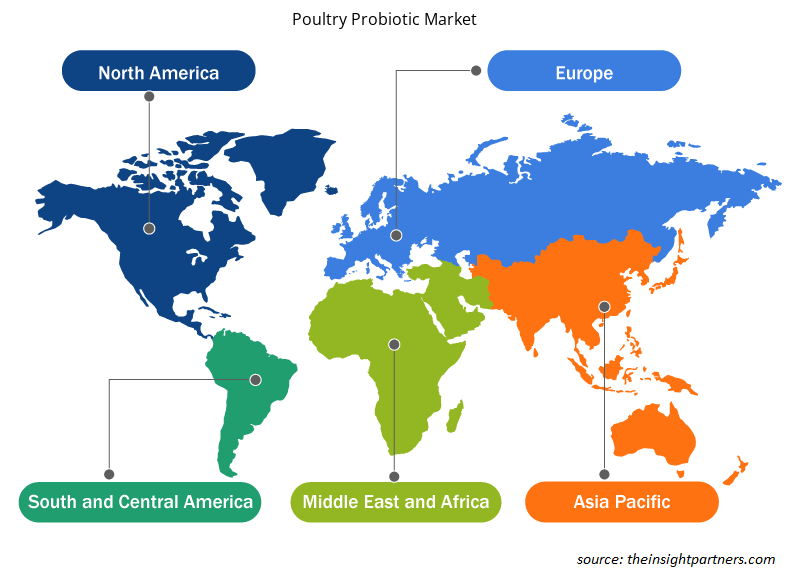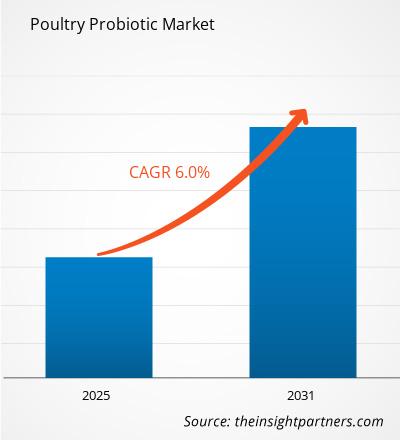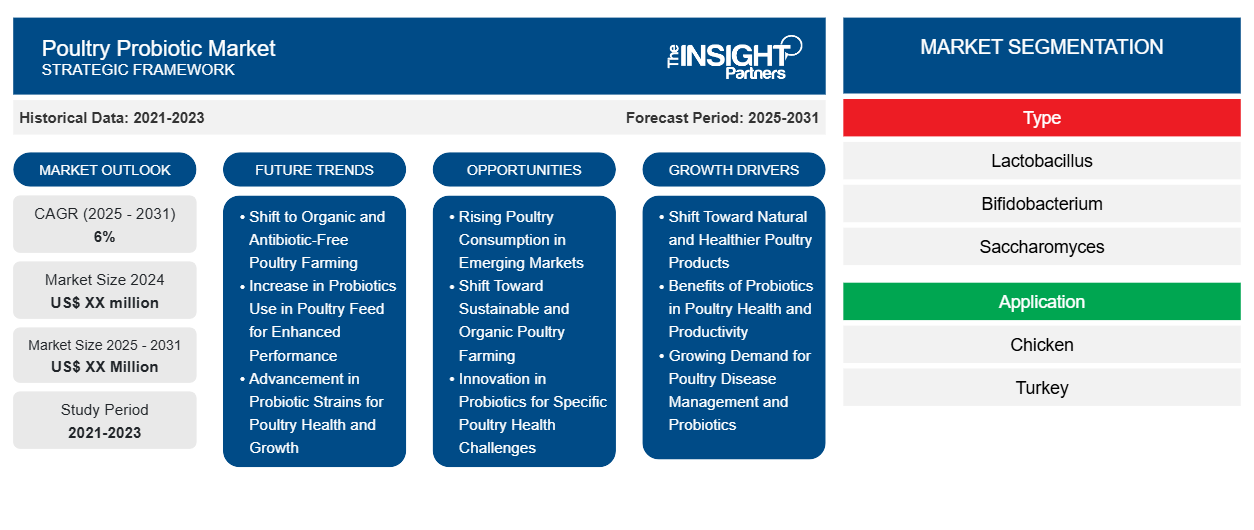Se espera que el mercado de probióticos avícolas registre una CAGR del 6% entre 2024 y 2031, con un tamaño de mercado que se expandirá de US$ XX millones en 2024 a US$ XX millones en 2031.
El informe está segmentado por tipo (Lactobacillus, Bifidobacterium, Saccharomyces, Streptococcus y otros). El informe presenta además un análisis basado en la aplicación (pollo, pavo y otros). El análisis global se desglosa aún más a nivel regional y por países principales. En términos geográficos, el mercado se divide en América del Norte, Europa, Asia Pacífico, Oriente Medio y África, y América del Sur y Central. El informe ofrece el valor en USD para el análisis y los segmentos anteriores.
Propósito del Informe
El informe Poultry Probiotic Market de The Insight Partners tiene como objetivo describir el panorama actual y el crecimiento futuro, los principales factores impulsores, los desafíos y las oportunidades. Esto proporcionará información a diversas partes interesadas del negocio, como:
- Proveedores/fabricantes de tecnología: Para comprender la dinámica cambiante del mercado y conocer las oportunidades potenciales de crecimiento, lo que les permitirá tomar decisiones estratégicas informadas.
- Inversionistas: Realizar un análisis exhaustivo de tendencias sobre la tasa de crecimiento del mercado, las proyecciones financieras del mercado y las oportunidades que existen en toda la cadena de valor.
- Órganos reguladores: Regular las políticas y vigilar las actividades del mercado con el objetivo de minimizar los abusos, preservar la confianza de los inversores y defender la integridad y la estabilidad del mercado.
Segmentación del mercado de probióticos avícolas
Tipo
- Lactobacilo
- Bifidobacteria
- Saccharomyces
- Estreptococo
Solicitud
- Pollo
- Pavo
Personalice este informe según sus necesidades
Obtendrá personalización en cualquier informe, sin cargo, incluidas partes de este informe o análisis a nivel de país, paquete de datos de Excel, así como también grandes ofertas y descuentos para empresas emergentes y universidades.
-
Obtenga las principales tendencias clave del mercado de este informe.Esta muestra GRATUITA incluirá análisis de datos, desde tendencias del mercado hasta estimaciones y pronósticos.
Factores impulsores del crecimiento del mercado de probióticos avícolas
- Cambio hacia productos avícolas más naturales y saludables: la creciente inclinación de los consumidores hacia productos avícolas más naturales y saludables está provocando la reducción del uso de antibióticos en la producción avícola. Una alternativa al uso de antibióticos, que es un probiótico para aves de corral, está ganando popularidad y, por lo tanto, está impulsando el mercado.
- Beneficios de los probióticos en la salud y la productividad de las aves de corral: En las aves de corral, el uso de probióticos mejora la digestión, la absorción de nutrientes y la salud de las aves, todo lo cual conduce a una mayor productividad. A medida que los agricultores se informan más sobre el papel de los probióticos en la mejora del bienestar de los animales y la reducción de la tasa de mortalidad, su uso está aumentando, lo que contribuye al crecimiento del mercado.Probiotics in Poultry Health and Productivity: In poultry, the use of probiotics enhances digestion, nutrient uptake and the health of the birds, all of which lead to improved productivity. As farmers become more informed about the role of probiotics in enhancing the welfare of animals and decreasing the mortality rate, their use is rising thus contributing to the growth of the market.
- Demanda creciente de probióticos y manejo de enfermedades avícolas: considerando el aumento de la población y el consumo de carne y huevos de aves de corral, especialmente en los países del tercer mundo, existe una demanda de un mejor manejo de las enfermedades avícolas. Los probióticos permiten una mejor tasa de conversión alimenticia y ofrecen buena salud a los animales, proporcionando así un importante factor complementario de producción que está aumentando el crecimiento del mercado.Probiotics: Considering the increase in population and consumption of poultry meat and eggs most particularly in the third world countries, there is a demand for better management of poultry diseases. Probiotics allow a better feed conversion ratio and offers good health to the animals, thus providing an important supplementary factor of production which is increasing market growth.
Tendencias futuras del mercado de probióticos avícolasProbiotic Market Future Trends
- Cambio a la cría de aves de corral orgánica y sin antibióticos: el uso de aditivos sintéticos y antibióticos está siendo reemplazado por el uso de productos más orgánicos, como los probióticos para aves de corral. A medida que los consumidores solicitan más pollos limpios y sin carne de cerdo, los granjeros están utilizando productos sin antibióticos, como los probióticos, para garantizar animales saludables y productivos junto con métodos de cría respetuosos con el medio ambiente.probiotics. As the consumers request more clean, pork free chicken, the farmers are utilizing antibiotics free products such as probiotics to ensure healthy and productive animals in tandem with environmentally friendly farming methods.
- Aumento del uso de probióticos en los alimentos para aves de corral para mejorar el rendimiento: la incorporación de probióticos en los alimentos compuestos está en aumento. Los granjeros y los productores de alimentos buscan mejorar las dietas de las aves de corral mediante la utilización de la investigación sobre probióticos para mejorar la salud intestinal y el rendimiento general de las aves y, por lo tanto, facilitar el enfoque integrado y holístico de la nutrición avícola que se practica actualmente.Probiotics Use in Poultry Feed for Enhanced Performance: The incorporation of probiotics in compounded feeds is now on the increase. Farmers and feed producers seek to enhance the diets of poultry by utilizing probiotic research in order to improve on the birds’ gut health and general performance and therefore facilitating the integrated and holistic approach to poultry nutrition practiced today.
- Avances en cepas probióticas para la salud y el crecimiento de las aves de corral: en el mercado de probióticos para aves de corral, se pueden observar cambios en la tendencia de crecimiento de las cepas probióticas a medida que aparecen productos más moderados diseñados para satisfacer la demanda de los clientes en materia de salud avícola. Hay tendencias cambiantes en lo que respecta al mercado, ya que se están fabricando probióticos revolucionarios destinados a prevenir enfermedades y promover el crecimiento de las aves de corral debido a los avances en la tecnología microbiana.Probiotic Strains for Poultry Health and Growth: In poultry probiotic market growth trend changes in probiotic strains can be observed as more moderated products designed for customer demand in poultry health appear. There are changing trends in regard to the market as revolutionized probiotics intended to prevent diseases and promote growth of poultry are being manufactured due to advancement in microbial technology.
Oportunidades de mercado para probióticos avícolas
- Aumento del consumo de aves de corral en los mercados emergentes: los países emergentes, especialmente en Asia y África, están aumentando su consumo de aves de corral, lo que allana el camino para el uso de probióticos para mejorar la salud y la producción avícola. La aparición de prácticas agrícolas modernas en estas áreas ha creado una necesidad de probióticos en la cría de aves de corral.
- Cambio hacia una avicultura sostenible y orgánica: la mayor atención a la avicultura sostenible y orgánica apunta inmediatamente a las posibilidades de uso de probióticos. Además, los aditivos naturales ayudan a combatir el miedo al uso excesivo de antibióticos, ya que cada vez más consumidores demandan productos avícolas orgánicos sin antibióticos.
- Innovación en probióticos para problemas específicos de salud de las aves de corral: existe la oportunidad de innovar y proporcionar probióticos específicos que aborden la salud intestinal, la intervención en enfermedades y los problemas de aumento de peso de las aves de corral. También es probable que el mercado avícola experimente un crecimiento al proporcionar diferentes soluciones dirigidas a las diferentes etapas de crecimiento de las aves de corral o incluso a diferentes razas de aves de corral.
Perspectivas regionales del mercado de probióticos avícolas
Los analistas de Insight Partners explicaron en detalle las tendencias y los factores regionales que influyen en el mercado de probióticos avícolas durante el período de pronóstico. Esta sección también analiza los segmentos y la geografía del mercado de probióticos avícolas en América del Norte, Europa, Asia Pacífico, Medio Oriente y África, y América del Sur y Central.

- Obtenga datos regionales específicos para el mercado de probióticos avícolas
Alcance del informe sobre el mercado de probióticos avícolas
| Atributo del informe | Detalles |
|---|---|
| Tamaño del mercado en 2024 | XX millones de dólares estadounidenses |
| Tamaño del mercado en 2031 | US$ XX millones |
| Tasa de crecimiento anual compuesta (CAGR) global (2025-2031) | 6% |
| Datos históricos | 2021-2023 |
| Período de pronóstico | 2025-2031 |
| Segmentos cubiertos |
Por tipo
|
| Regiones y países cubiertos |
América del norte
|
| Líderes del mercado y perfiles de empresas clave |
|
Densidad de actores del mercado de probióticos avícolas: comprensión de su impacto en la dinámica empresarial
El mercado de probióticos avícolas está creciendo rápidamente, impulsado por la creciente demanda de los usuarios finales debido a factores como la evolución de las preferencias de los consumidores, los avances tecnológicos y una mayor conciencia de los beneficios del producto. A medida que aumenta la demanda, las empresas amplían sus ofertas, innovan para satisfacer las necesidades de los consumidores y aprovechan las tendencias emergentes, lo que impulsa aún más el crecimiento del mercado.
La densidad de actores del mercado se refiere a la distribución de las empresas o firmas que operan dentro de un mercado o industria en particular. Indica cuántos competidores (actores del mercado) están presentes en un espacio de mercado determinado en relación con su tamaño o valor total de mercado.
Las principales empresas que operan en el mercado de probióticos avícolas son:
- ADM
- Chr. Hansen Holding A/S
- Adisseo
- Alltech
- Tierra O'Lakes, Inc.
Descargo de responsabilidad : Las empresas enumeradas anteriormente no están clasificadas en ningún orden particular.

- Obtenga una descripción general de los principales actores clave del mercado de probióticos avícolas
Puntos de venta clave
- Cobertura integral: el informe cubre de manera integral el análisis de productos, servicios, tipos y usuarios finales del mercado de probióticos avícolas, proporcionando un panorama holístico.
- Análisis de expertos: el informe se compila sobre la base de un profundo conocimiento de expertos y analistas de la industria.
- Información actualizada: El informe asegura relevancia comercial debido a su cobertura de información reciente y tendencias de datos.
- Opciones de personalización: este informe se puede personalizar para satisfacer los requisitos específicos del cliente y adaptarse adecuadamente a las estrategias comerciales.
Por lo tanto, el informe de investigación sobre el mercado de probióticos avícolas puede ayudar a abrir camino para descifrar y comprender el escenario de la industria y las perspectivas de crecimiento. Si bien puede haber algunas preocupaciones válidas, los beneficios generales de este informe tienden a superar las desventajas.
- Análisis histórico (2 años), año base, pronóstico (7 años) con CAGR
- Análisis PEST y FODA
- Tamaño del mercado, valor/volumen: global, regional y nacional
- Industria y panorama competitivo
- Conjunto de datos de Excel
Informes recientes
Informes relacionados
Testimonios
Razón para comprar
- Toma de decisiones informada
- Comprensión de la dinámica del mercado
- Análisis competitivo
- Información sobre clientes
- Pronósticos del mercado
- Mitigación de riesgos
- Planificación estratégica
- Justificación de la inversión
- Identificación de mercados emergentes
- Mejora de las estrategias de marketing
- Impulso de la eficiencia operativa
- Alineación con las tendencias regulatorias























 Obtenga una muestra gratuita para - Mercado de probióticos avícolas
Obtenga una muestra gratuita para - Mercado de probióticos avícolas